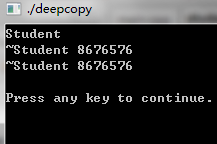先考虑一种情况,对一个已知对象进行拷贝,编译系统会自动调用一种构造函数——拷贝构造函数,如果用户未定义拷贝构造函数,则会调用默认拷贝构造函数。
//main.cpp #include <iostream> #include "student.h" int main() { Student s1; Student s2(s1);//Student s2 = s1;//复制对象 return 0; }
//student.h #ifndef STUDENT_H #define STUDENT_H class Student { private: int num; char *name; public: Student(); ~Student(); }; #endif
//student.cpp #include "student.h" #include <iostream> using namespace std; Student::Student() { name = new char(20); cout << "Student" << endl; } Student::~Student() { cout << "~Student " << (int)name << endl; delete name; name = NULL; }
执行结果:调用一次构造函数,调用两次析构函数,两个对象的指针成员所指内存相同,这会导致什么问题呢?

name指针被分配一次内存,但是程序结束时该内存却被释放了两次,会造成内存泄漏问题!
这是由于编译系统在我们没有自己定义拷贝构造函数时,会在拷贝对象时调用默认拷贝构造函数,进行的是浅拷贝!即对指针name拷贝后会出现两个指针指向同一个内存空间。

所以,在对含有指针成员的对象进行拷贝时,必须要自己定义拷贝构造函数,使拷贝后的对象指针成员有自己的内存空间,即进行深拷贝,这样就避免了内存泄漏发生。
自己定义拷贝构造函数:
//student.h
#ifndef STUDENT_H
#define STUDENT_H
class Student
{
private:
int num;
char *name;
public:
Student();//构造函数
~Student();//析构函数
Student(const Student &s);//拷贝构造函数,const防止对象被改变
};
#endif
//student.cpp #include "student.h" #include <iostream> #include <string.h> using namespace std; Student::Student() { name = new char(20); cout << "Student " << endl; } Student::~Student() { cout << "~Student " << (int)name << endl; delete name; name = NULL; } Student::Student(const Student &s) { name = new char(20); memcpy(name, s.name, strlen(s.name)); cout << "copy Student " << endl; }
执行结果:调用一次构造函数,一次自定义拷贝构造函数,两次析构函数。两个对象的指针成员所指内存不同。

总结:浅拷贝只是对指针的拷贝,拷贝后两个指针指向同一个内存空间,深拷贝不但对指针进行拷贝,而且对指针指向的内容进行拷贝,经深拷贝后的指针是指向两个不同地址的指针。
再说几句:
当对象中存在指针成员时,除了在复制对象时需要考虑自定义拷贝构造函数,还应该考虑以下两种情形:
1.当函数的参数为对象时,实参传递给形参的实际上是实参的一个拷贝对象,系统自动通过拷贝构造函数实现;
2.当函数的返回值为一个对象时,该对象实际上是函数内对象的一个拷贝,用于返回函数调用处。
最后再留一个问题:对象的复制和赋值有什么区别?各自的应用场景是怎么样的?
本文参考: